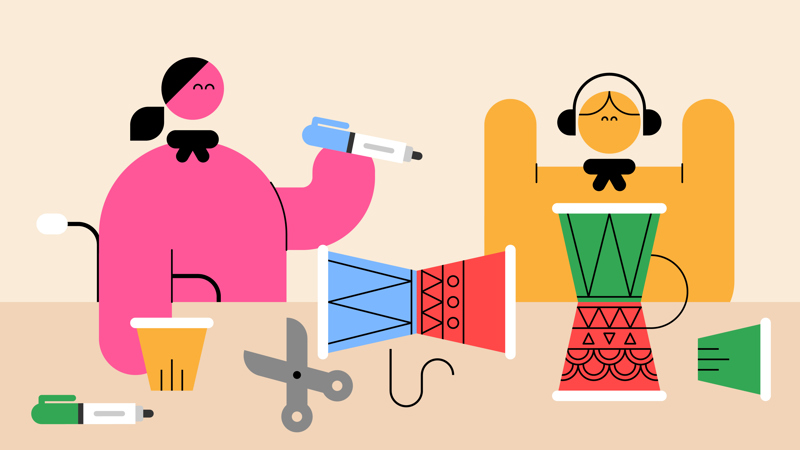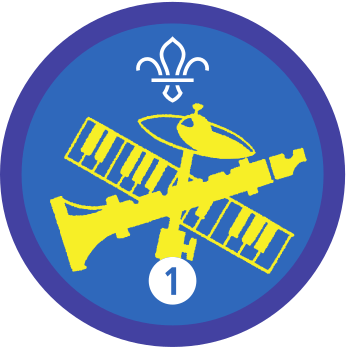
Make your own Djembe drums
You’ll need
- Scissors
- Elastic bands
- String
- PVA glue
- Masking tape
- Coloured pens or pencils
- Paint
- Paint brushes
- Plant pots
- Paper cups
- Old plastic bag (with no holes)
- African symbols, African prints or fabric, African beads to decorate the drums (optional)
Before you begin
- Use the safety checklist to help you plan and risk assess your activity. There's also more guidance to help you carry out your risk assessment, including examples.
- Make sure all young people and adults involved in the activity know how to take part safely.
- Make sure you’ll have enough adult helpers. You may need some parents and carers to help.
Planning and setting up this activity
- It’s up to you whether you use paper cups or plant pots to make your drum – both work well.
- It may be useful to make a drum before everyone arrives, so you can show them what they’re aiming for.
What’s a djembe?
- A djembe (pronounced ‘jem-bay’) is a drum originally from West Africa. People play djembes with their hands. According to the Bambara people in Mali, the name of the djembe comes from the saying ‘Anke djé, anke bé’, which translates to ‘Everyone gather together in peace’. The saying also explains a bit about the drum’s purpose.
Running this activity
- Gather everyone together in a circle and ask everyone if they can name any countries in Africa. For example, Kenya, Ghana, Madagascar, Nigeria, and so on.
- Explain that djembes are drums from West Africa.
- Tell everyone their going to make their own djembes and give out the materials.
- First, use masking tape to stick the bottoms of two cups together.
- Decorate the cups with colouring pens and pencils.
- Tie an elastic band loosely where the two cups join. It should be over the masking tape.
- Lay a plastic bag out flat. Put a cup upside down on the bag and draw a circle around it using a marker pen.
- Take the cup away and draw a larger circle around the circle you’ve just drawn.
- Cut carefully around the bigger circle with scissors. It’s OK for an adult to help with this.
- Put the plastic bag circle on top of the drum. Pull the plastic tight, and use another rubber band to hold it in place. Don’t worry if it’s a bit tricky – this is a great time to work in pairs.
- Cut a fairly long piece of wool.
- Tie one end of the wool onto the rubber band in the middle of the drum.
- Loop the wool up and underneath the top rubber band, then pull it so it’s straight and tie it on with a knot.
- Keep zig-zagging the wool around the drum, going over and under the two rubber bands and tying knots to secure it in place.
- If you run out of wool (or want to use more than one colour). Just trim the wool after you’ve tied it to an elastic band, then tie the new piece of wool on next to it and keep going.
- If anyone wants to, they could create a handle by looping a piece of wool from the rubber band around the top of their drum to the one around its middle.
- At the end, you could gather in a circle. Someone could clap out or play a simple rhythm. Everyone else can then repeat it back on their drums. You could put on a small performance for parents and carers.
Funga alafia
This is a ‘welcome dance’ song, sung in the Yoruba language used in countries including Nigeria and Liberia. You can drum or dance along to this song to welcome everyone.
Leader: Funga alafia (fun-ga a-la-fi-ya)
Group: Asé, asé (ah-shay)
O zim zim
A simple drumming call-and-response song from West Africa.
Leader: O zim zim
Group: O zim
Leader: O racataya
Group: O ya
Do do ki do
A Cameroonian children’s song, sung with drumming for a Cameroonian mask dance.
All:
Do do ki do, ti na baba
Do do ki do, ti na baba
Do do do, ti la so la so
Kye Kye Kule
This is a call-and-response song from Ghana. It is similar to 'Heads, Shoulders, Knees and Toes' so you should do the actions when singing this song.
Leader: Kye Kye Kule (chay chay koo-lay)
Group: Kye Kye Kule
(Hands on your head)
Leader: Kye Kye Kofinsa (chay chay koh-feen sah)
Group: Kye Kye Kofisa
(Hands on your shoulders)
Leader: Kofisa Langa (koh-fee sah lahn-gah)
Group: Kofisa Langa
(Hands on your waist)
Leader: Kaka Shilanga (kah-kah shee lahn-gah)
Group: Kaka Shilanga
(Hands on your knees)
Leader: Kum Aden Nde (koom ah-dehn day)
Group: Kum Aden Nde
(Hands on your ankles)
Leader: Kum Aden Nde (koom ah-dehn day)
Group: Kum Aden Nde, HEY!
(Hands on your ankles)
Black History Month takes place every October in the UK. It started in the United States in 1926. In the UK, Black History Month began in 1987 and is an important opportunity to celebrate and learn about Black history. During this month, schools and communities hold events, activities, and discussions to highlight important figures, such as activists, artists, and leaders. This month is a chance for everyone to appreciate the rich culture and history of Black communities and to understand the impact they have had on our society. However, it’s important to remember that Black history is a part of history that people can (and should) learn about all year round.
This activity has been chosen as it celebrates Black music.
Reflection
Going around the circle, play a short rhythm then say how you found the session – for example, *beat* *tap* ‘fun’. The rest of the group can then repeat this. It’s OK to use the same words as each other to describe the session.
Music can bring us together and help us learn about different cultures. What did you enjoy about the songs? Why is it good to learn about different cultures? (To celebrate our differences, understand others and find similarities.)
Congratulations for playing and having the confidence to perform in front of an audience. How do you think it went? Even if you weren’t happy with your performance, remember you only had a short time to learn something new. This performance doesn’t need to be perfect, but if you keep practising, over time you will get better.
Safety
All activities must be safely managed. You must complete a thorough risk assessment and take appropriate steps to reduce risk. Use the safety checklist to help you plan and risk assess your activity. Always get approval for the activity, and have suitable supervision and an InTouch process.
- Scissors
Supervise young people appropriately when they’re using scissors. Store all sharp objects securely, out of the reach of young people.
- Rubbish and recycling
All items should be clean and suitable for this activity.
To make this easier, you can use call-and-response songs, or play and repeat rhythms.
Spread this activity over two meetings to allow everyone more time to practise the songs before performing them.
All Scout activities should be inclusive and accessible.
Invite some musicians who know the music to run a workshop for your section.
Watch a performance that uses African drums. You can find videos of performances online.
Learn about and try making some instruments from other parts of the world.
A young person could lead the group during the songs or when coming up with rhythms.
